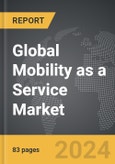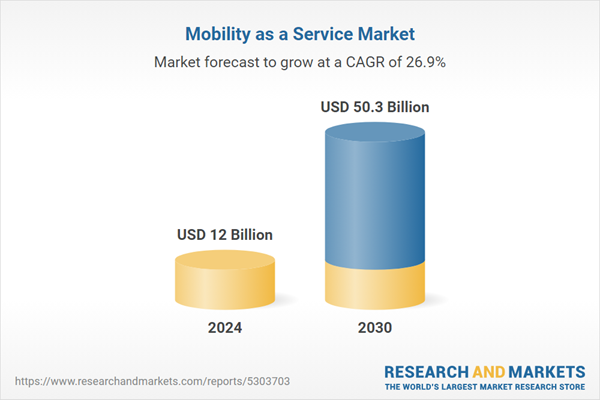The global market for Mobility as a Service was valued at US$12.0 Billion in 2024 and is projected to reach US$50.3 Billion by 2030, growing at a CAGR of 26.9% from 2024 to 2030. This comprehensive report provides an in-depth analysis of market trends, drivers, and forecasts, helping you make informed business decisions. The report includes the most recent global tariff developments and how they impact the Mobility as a Service market.
Segments: Transportation Type (Private, Public); Service Type (Ride Hailing, Car Sharing, Micromobility); Business Model (Business-to-Consumer, Business-to-Business, Peer-to-Peer).
Geographic Regions/Countries: World; United States; Canada; Japan; China; Europe (France; Germany; Italy; United Kingdom; Spain; Russia; and Rest of Europe); Asia-Pacific (Australia; India; South Korea; and Rest of Asia-Pacific); Latin America (Argentina; Brazil; Mexico; and Rest of Latin America); Middle East (Iran; Israel; Saudi Arabia; United Arab Emirates; and Rest of Middle East); and Africa.
The analysts continuously track trade developments worldwide, drawing insights from leading global economists and over 200 industry and policy institutions, including think tanks, trade organizations, and national economic advisory bodies. This intelligence is integrated into forecasting models to provide timely, data-driven analysis of emerging risks and opportunities.
Global Mobility as a Service Market - Key Trends and Drivers Summarized
How Is Mobility as a Service Revolutionizing Urban Transport?
Mobility as a Service (MaaS) integrates various transportation services into a single digital platform, offering a convenient and efficient solution for urban mobility. The platform combines public transport, ride-sharing, car rentals, bike-sharing, and other mobility options into a single app that allows users to plan, book, and pay for trips seamlessly. MaaS aims to shift people away from private vehicle ownership toward shared mobility, reducing traffic congestion and the environmental impact of urban transport. By providing flexible and on-demand travel options, MaaS addresses the challenges of transportation in modern cities, including limited parking, pollution, and inefficient public transport. MaaS is gaining traction across the globe, driven by rising urbanization, increasing smartphone usage, and the need for sustainable mobility solutions. Countries in Europe, North America, and Asia-Pacific are at the forefront of MaaS implementation, with several cities launching pilot projects to test different MaaS models. Governments and local authorities are recognizing the potential of MaaS to reduce the reliance on private vehicles, thereby alleviating congestion and promoting greener mobility options. In addition, technological advancements, such as 5G connectivity and AI, are enabling real-time updates and personalized travel recommendations, enhancing the MaaS user experience.What Trends Are Shaping the Mobility as a Service Market?
Several key trends are influencing the growth of MaaS, including the shift towards integrated multimodal transport, the rise of electric and autonomous vehicles, and the emphasis on data-driven insights. The concept of Mobility as a Service supports multimodal transport by combining various modes into a seamless journey. This integration encourages people to adopt a mix of transport options, from public buses to e-scooters, for different legs of their trip, leading to a reduction in carbon footprints. Additionally, the adoption of electric and autonomous vehicles within MaaS ecosystems is expected to transform urban mobility by making it more sustainable and efficient. Data analytics is playing a crucial role in the evolution of MaaS by providing insights into travel patterns, user preferences, and demand forecasting. By leveraging these insights, service providers can optimize routes, reduce wait times, and improve the overall quality of service. Moreover, partnerships between public and private transportation providers are becoming more common, creating unified systems that benefit from the strengths of both sectors. The development of flexible pricing models, such as subscription-based packages or pay-per-use options, is further shaping MaaS by making it accessible and cost-effective for different user groups.How Do Market Segments Define the Growth of Mobility as a Service?
Service types include ride-hailing, car-sharing, bike-sharing, public transit, and e-scooter rentals, with ride-hailing being one of the most popular options due to its convenience. Applications vary from personal use to business travel and logistics, where MaaS platforms facilitate last-mile deliveries and optimize corporate transportation. In terms of regional adoption, Europe leads the market, with cities like Helsinki, London, and Berlin implementing advanced MaaS solutions. North America follows, with growing interest in sustainable transport options, while Asia-Pacific is experiencing rapid expansion driven by urbanization and government initiatives.What Factors Are Driving the Growth in the Mobility as a Service Market?
The growth in the Mobility as a Service market is driven by several factors, including increasing urbanization, the need for sustainable transport, advancements in digital technology, and supportive government policies. The trend towards smart cities is encouraging the adoption of MaaS to tackle urban mobility challenges such as congestion and pollution. Governments are actively promoting MaaS through funding and incentives, making it easier for service providers to launch and scale operations. Moreover, the shift in consumer preferences toward flexible, pay-per-use models and the convenience of integrated travel solutions are driving the market forward. The rise of electric and autonomous vehicles within MaaS platforms also supports sustainable growth, appealing to eco-conscious consumers.Report Scope
The report analyzes the Mobility as a Service market, presented in terms of units. The analysis covers the key segments and geographic regions outlined below.Segments: Transportation Type (Private, Public); Service Type (Ride Hailing, Car Sharing, Micromobility); Business Model (Business-to-Consumer, Business-to-Business, Peer-to-Peer).
Geographic Regions/Countries: World; United States; Canada; Japan; China; Europe (France; Germany; Italy; United Kingdom; Spain; Russia; and Rest of Europe); Asia-Pacific (Australia; India; South Korea; and Rest of Asia-Pacific); Latin America (Argentina; Brazil; Mexico; and Rest of Latin America); Middle East (Iran; Israel; Saudi Arabia; United Arab Emirates; and Rest of Middle East); and Africa.
Key Insights:
- Market Growth: Understand the significant growth trajectory of the Private segment, which is expected to reach US$49.0 Billion by 2030 with a CAGR of a 27.3%. The Public segment is also set to grow at 14.7% CAGR over the analysis period.
- Regional Analysis: Gain insights into the U.S. market, valued at $3.0 Billion in 2024, and China, forecasted to grow at an impressive 33.9% CAGR to reach $14.8 Billion by 2030. Discover growth trends in other key regions, including Japan, Canada, Germany, and the Asia-Pacific.
Why You Should Buy This Report:
- Detailed Market Analysis: Access a thorough analysis of the Global Mobility as a Service Market, covering all major geographic regions and market segments.
- Competitive Insights: Get an overview of the competitive landscape, including the market presence of major players across different geographies.
- Future Trends and Drivers: Understand the key trends and drivers shaping the future of the Global Mobility as a Service Market.
- Actionable Insights: Benefit from actionable insights that can help you identify new revenue opportunities and make strategic business decisions.
Key Questions Answered:
- How is the Global Mobility as a Service Market expected to evolve by 2030?
- What are the main drivers and restraints affecting the market?
- Which market segments will grow the most over the forecast period?
- How will market shares for different regions and segments change by 2030?
- Who are the leading players in the market, and what are their prospects?
Report Features:
- Comprehensive Market Data: Independent analysis of annual sales and market forecasts in US$ Million from 2024 to 2030.
- In-Depth Regional Analysis: Detailed insights into key markets, including the U.S., China, Japan, Canada, Europe, Asia-Pacific, Latin America, Middle East, and Africa.
- Company Profiles: Coverage of players such as Beeline Singapore, Citymapper, Communauto, Deutsche Bahn AG, DiDi Chuxing and more.
- Complimentary Updates: Receive free report updates for one year to keep you informed of the latest market developments.
Some of the 26 companies featured in this Mobility as a Service market report include:
- Beeline Singapore
- Citymapper
- Communauto
- Deutsche Bahn AG
- DiDi Chuxing
- Grab
- Lyft, Inc.
- MaaS Global Oy
- Mobilleo
- Moovel Group
- Moovit Inc.
- Qixxit
- SkedGo Pty Ltd
- Splyt Technologies Ltd,
- Transit Systems Pty Ltd.
- Tranzer
- Uber Technologies Inc.
- UbiGo AB
Tariff Impact Analysis: Key Insights for 2025
Global tariff negotiations across 180+ countries are reshaping supply chains, costs, and competitiveness. This report reflects the latest developments as of April 2025 and incorporates forward-looking insights into the market outlook.The analysts continuously track trade developments worldwide, drawing insights from leading global economists and over 200 industry and policy institutions, including think tanks, trade organizations, and national economic advisory bodies. This intelligence is integrated into forecasting models to provide timely, data-driven analysis of emerging risks and opportunities.
What’s Included in This Edition:
- Tariff-adjusted market forecasts by region and segment
- Analysis of cost and supply chain implications by sourcing and trade exposure
- Strategic insights into geographic shifts
Buyers receive a free July 2025 update with:
- Finalized tariff impacts and new trade agreement effects
- Updated projections reflecting global sourcing and cost shifts
- Expanded country-specific coverage across the industry
Table of Contents
I. METHODOLOGYII. EXECUTIVE SUMMARY2. FOCUS ON SELECT PLAYERSIII. MARKET ANALYSISCANADAITALYSPAINRUSSIAREST OF EUROPESOUTH KOREAREST OF ASIA-PACIFICARGENTINABRAZILMEXICOREST OF LATIN AMERICAIRANISRAELSAUDI ARABIAUNITED ARAB EMIRATESREST OF MIDDLE EASTIV. COMPETITION
1. MARKET OVERVIEW
3. MARKET TRENDS & DRIVERS
4. GLOBAL MARKET PERSPECTIVE
UNITED STATES
JAPAN
CHINA
EUROPE
FRANCE
GERMANY
UNITED KINGDOM
ASIA-PACIFIC
AUSTRALIA
INDIA
LATIN AMERICA
MIDDLE EAST
AFRICA
Companies Mentioned (Partial List)
A selection of companies mentioned in this report includes, but is not limited to:
- Beeline Singapore
- Citymapper
- Communauto
- Deutsche Bahn AG
- DiDi Chuxing
- Grab
- Lyft, Inc.
- MaaS Global Oy
- Mobilleo
- Moovel Group
- Moovit Inc.
- Qixxit
- SkedGo Pty Ltd
- Splyt Technologies Ltd,
- Transit Systems Pty Ltd.
- Tranzer
- Uber Technologies Inc.
- UbiGo AB
Table Information
| Report Attribute | Details |
|---|---|
| No. of Pages | 83 |
| Published | April 2025 |
| Forecast Period | 2024 - 2030 |
| Estimated Market Value ( USD | $ 12 Billion |
| Forecasted Market Value ( USD | $ 50.3 Billion |
| Compound Annual Growth Rate | 26.9% |
| Regions Covered | Global |









